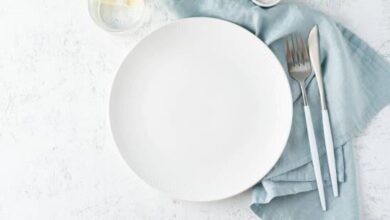Are Porcelain Plates Better than Ceramic Plates?
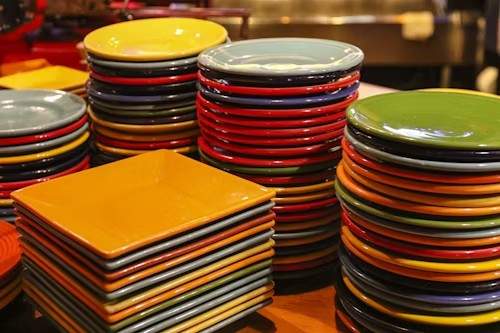
Plates are a must-have in every household around the world. And rightly so! They’re the oh-so-important vessels that hold your every meal. They come in several sizes, shapes, colors, and materials, which is more than enough to handle any and all occasions.
The versatility of plates cannot be overemphasized. They range from huge dinner plates enough to hold food for two to small appetizer plates. This is particularly important if you love having friends and family over for dinner parties. Having a diverse collection of plates will ensure you present meals to your guests like a five-star hotel.
Porcelain and ceramic plates are more often than not the go-to due to their aesthetics, functionality, and overall durability. While they may share origins, particularly being crafted from clay and fired in extremely hot furnaces, each holds a different composition and properties from the other. This makes them great options for various culinary situations.
Knowing the differences between ceramic and porcelain plates can help you make the right decisions that fit your needs and preferences.
In this post, we’ll cover the vast nuances of porcelain and ceramic plates, going over various aspects such as their build, characteristics, pros each one has over the other, and what to look for when getting either. So if you’re a culinary enthusiast, love hosting, or are simply looking to expand your dinner set, grab a beverage and get comfortable. We guarantee that by the end, you will have enough knowledge to curate a dinner set that shows your style.
What Is A Porcelain Plate?
Porcelain has a rich history, with its roots going all the way back to ancient China. Back in the day, it was highly sought after and still is to date. If you’ve ever heard someone refer to a dinner set as “fine china,” that’s more than likely a porcelain set.
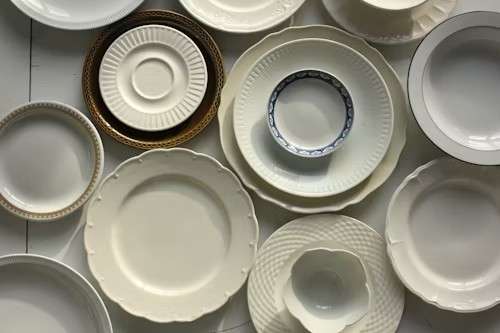
Porcelain plates are the obvious pick for high-end restaurants because of their polished look and extreme beauty. These characteristics are what make them ideal for formal dinner settings.
They are made from a special clay that’s burned at higher than usual temperatures. The end result is a more delicate and refined product. It is also less porous than most ceramics and, overall, much stronger. This means it is more resistant to fractures and scratches while still being visually appealing.
Composition
Apart from clay, porcelain is also made from feldspar, quartz sand, and kaolin. It’s also possible to contain additional material such as bone, ash, granite, glass, alabaster, steatite, petuntse, and so forth.
Porcelain often begins as a paste, and there are two main forms: hard and soft. Hard porcelain paste is a mix of petuntse and kaolin clay, while the soft paste is made from white clay and variations of powdered glass. While trying to duplicate the highly valued Chinese and Japanese porcelain, the Europeans invented soft-paste porcelain.
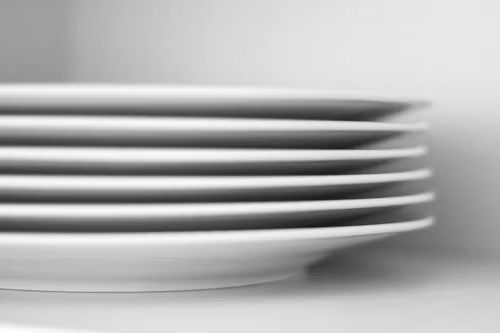
Bone china is also another form of porcelain. Although it’s not as popular, it is made from a mix of kaolin and animal bone ash. This results in a surface that is more delicate, thinner, and a tad bit more transparent than standard porcelain dinner sets.
How to Use Porcelain Plates
Porcelain plates are great for special events, formal dinners, and entertaining your guests. Their unique look and overall design make them a great conversation starter. These plates are popular both in homes and fine dining spots around the world. They’re dishwasher safe but can easily be damaged due to variations in excessive temperatures.
Characteristics
Porcelain plates have a smooth, delicate, and shiny texture commonly associated with fine china dinner sets. These plates are often off-white or white in color and will give any table they are set on a classic appearance.
Its exceptionally high degree of whiteness and translucency is what makes it a popular choice for high-end dinnerware and formal events. This level of refinement and beauty, compared to other ceramics, is attributed to porcelain’s unique composition. It’s also why porcelain plates have a great tolerance to thermal shock from a various cooking and serving applications
Thanks to these magnificent characteristics, porcelain stands as the go-to choice for dinnerware in restaurants and homes around the world.
Why you Should Buy Porcelain Plates
Durability
Porcelain plates are fired at extremely high temperatures for longer periods of time, and this makes them extremely resistant to chipping and scratches.
Stain Resistance
Because of its non-porous nature, porcelain will never collect stains, food atoms, or tastes. This makes cleaning and maintaining it much easier.
Beauty
Porcelain plates are known for their smooth and shiny surface, which adds a touch of class and beauty to your dining experience.
Appearance
Porcelain plates are often translucent, and this makes them look more exquisite and polished. It’s the perfect vessel to hold a diverse range of culinary masterpieces.
Heat Retention
Porcelain plates hold heat incredibly well. Once served hot, meals will remain warm on these plates for a longer time compared to other ceramics.
What to Consider before Buying Porcelain Plates
Fragility
Despite being durable, porcelain is still fragile and can break if not stored and handled with great caution. It’s also not impervious to cracking and chipping
Cost
It’s typically more expensive to own porcelain dinnerware. However, if you don’t mind the exuberant upfront cost, it’s a great choice for those special event dinners.
What Is A Ceramic Plate?
Ceramic generally refers to a wide range of clay-based kitchenware. They are often made from a mixture of water and clay or other ceramic materials. Ceramic plates are some of the most recognizable dinnerware thanks to their timeless appeal, durability, and great adaptability.
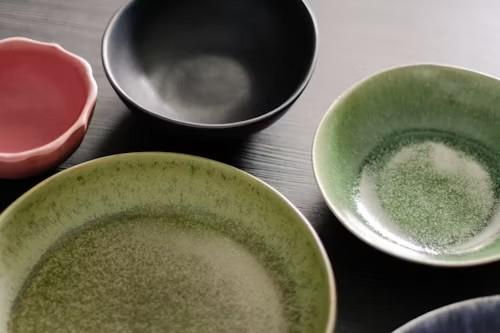
Ceramic plates have been the staple dinnerware for centuries because of their cost and overall flexibility. They come in various designs, colors, and patterns suitable for a large range of aesthetics and eating styles.
Composition
Ceramics are a combination of minerals and natural ball clay held together by water. This composition makes it a fan favorite among artists and craftspeople who love stretching the limits of what it can make.
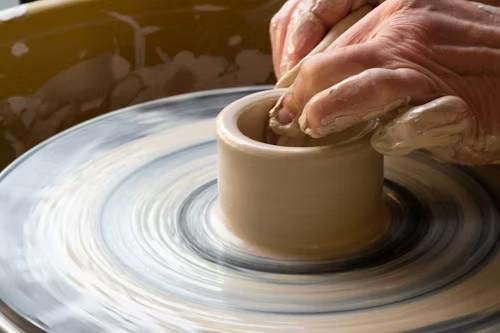
Ceramic plates are fired at generally low temperatures in comparison to porcelain. The clay’s composition and desired look by the maker also determine the firing temperature. As such, this makes them a tad bit more porous compared to porcelain plates.
When to Use Ceramic Plates
Ceramic plates are often the pick for both formal and informal dining. They are highly reliable thanks to their durability and aesthetic appeal, which makes them great for indoor and outdoor dining.
You should, however, note that their porous nature makes them unsuitable for highly acidic foods or foods that leave stains. Ceramic plates are a great addition to get for your kitchen. They are a versatile dinnerware selection and will be a great gift for future generations.
Characteristics
Thanks to their manufacturing process, ceramic plates often come out with a more rustic or handcrafted appearance. This process also contributes to the various styles and colors ceramics are available in, making them adaptable to different table settings and personal tastes.
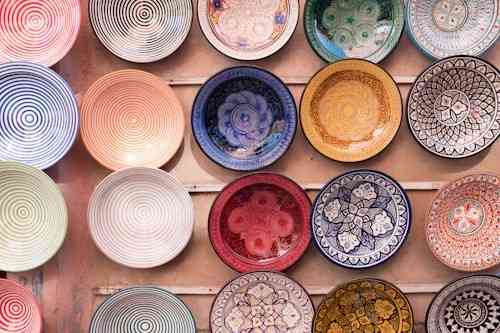
Ceramic tableware is also inexpensive compared to porcelain, making it a popular kitchen must-have for everyday use in homes all through the world.
Why You Should Buy Ceramic Plates
Affordability
Ceramic is often cheaper than porcelain. It’s a great alternative for anyone looking for quality dinnerware while on a budget.
Versatility
Ceramic plates are usually microwave-safe and can also endure intense dishwashing. This, however, depends on the manufacturing and grazing process.
Durability
Ceramic may be more porous than porcelain, but it’s still very durable and can sustain heavy daily use. With proper maintenance, you even increase its longevity tenfold.
Variety
Ceramic plates come in a large range of colors, patterns, and designs, enough to fit the diverse tastes and kitchen aesthetics of people around the world. These plates are a popular selection for anyone looking to make a style statement in their household.
Health
Since ceramic plates are mostly made from naturally occurring, non-toxic clay, they are generally considered safe to use for food preparation and serving.
Non-Stick Properties
Ceramic plates have proper non-stick and greaseproof properties. Ceramic’s smooth glass texture makes it a breeze to clean without causing any scratches. With basic soap and water, you can easily restore ceramic plates to their original glory.
What To Consider Before Buying Ceramic Plates
Weight
Ceramic plates are often heavier in comparison to porcelain counterparts. Once laid on the table, people with limited mobility will find it challenging to lift or move them.
Heat Retention
Ceramic may heat up quickly, but once served, food may not stay warm for long. So if you like hot meals, you may want to reconsider your options
How to Pick the Right Plate for You
Consider The Usage
Ceramic plates will be your best bet if you want to get plates for daily use or simple dinner hosting events. These plates are often budget-friendly and come in several unique designs and styles to suit your latest.
If you’re leaning towards hosting formal dinners, elegant events, or special celebrations, get yourself porcelain plates. Their highly refined appearance and style will lend your meals a unique and sophisticated dining experience, making them a worthy investment.
Analyze Durability
Think about how often you plan to use the plates you want to buy. The more you use them, the more they will have to go through great wear and tear.
Porcelain platters are generally recognized for their durability and chipping resistance.
As such, they’ll be ideal for numerous uses and washing. You’ll also want to think about the longevity of the plates you invest in. Higher-quality porcelain is bound to last longer and require fewer replacements of ceramic plates in the long run.
Assess Your Style Preferences
Before settling on the plates you want, you should consider the type of aesthetic of your dining area and overall personal style you subscribe to. Ceramic plates often come in several classy patterns, colors, and designs. This will allow you to express your style while matching your dining table aesthetics.
On the other hand, porcelain plates have a timeless and classic elegance that is usually great for formal settings or anyone seeking a refined dining experience. They add a touch of luxury to your dining setup thanks to their high level of sophistication and sleekness.
Budget Considerations
Have a clear line of sight in terms of budget and compare the initial costs between porcelain and ceramic plates. Yes, ceramic plates are more budget-friendly at the start. But you should also consider the long-term savings you can get if you invest in durable, long-lasting porcelain plates.
In a couple of years, you can recoup the cost of porcelain plates, as their resistance to chipping and overall durability ensure they last lifetimes with minimal replacement in the future.
Final Thoughts
It’s evident that both porcelain and ceramic plates have a lot going for them. From the looks of things, each one has something to offer your dining experience.
Choosing between porcelain and ceramic plates can be a very complex decision due to the many features each one holds. They are both timeless classics with different offerings depending on the occasion, style, and aesthetic appeal.
So before picking one on the fly, we suggest you understand what they bring to the table and also consider your individual preferences. That way you can curate a dinnerware collection that is practical and also adds flair to your culinary experience.
Frequently Asked Questions (FAQs):
Q1. Which is better, porcelain or ceramic plates?
Q2. Which plate is more expensive, ceramic or porcelain?
Porcelain is often more expensive because of the finer materials and high temperatures used in the manufacturing process.
Q3. Can you microwave ceramic and porcelain plates?
Yes, these plates can be placed in the microwave unless the label on the back says otherwise. Ceramic might overheat unevenly, though.
Q4. Are ceramic plates dishwasher safe?
Yes, most modern ceramic plates are dishwasher safe. However, handwashing them is more gentle on the glazes.
Q5. What is the main visual difference between porcelain and ceramic plates?
Porcelain tends to be whiter, smoother, and a lot more refined compared to ceramic, which feels rustic and thicker.
Q6. Do porcelain plates chip or break easily?
No, not really. They may look delicate, but porcelain plates are far more resistant to chipping and breaking than ceramic counterparts.

